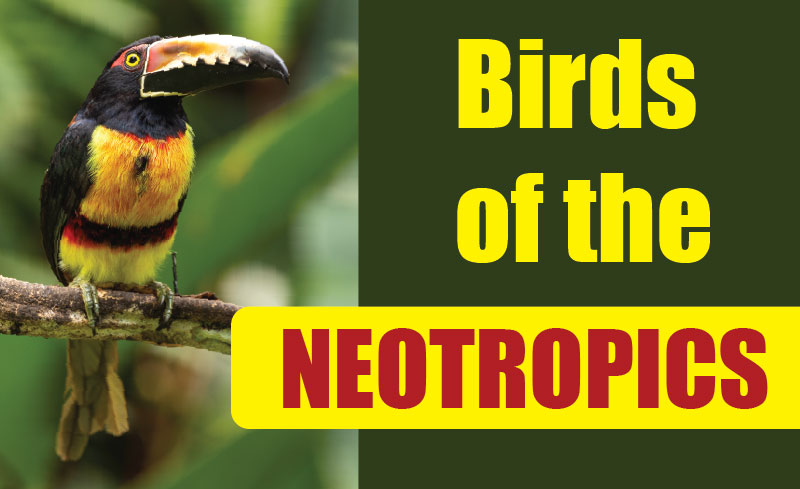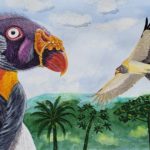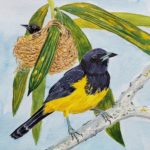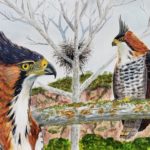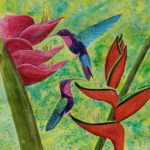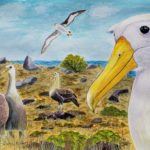I love observing and filming birds in the wild and below you can find information and short videos of exceptional species native to the Neotropics.
- King Vulture painting by Christine Elder
- Montserrat Oriole
- Ornate Hawk-Eagle
- Plate-billed Mountain-Toucan
- Purple Carib
- Waved Albatross
LINKS TO INFORMATION ABOUT THE SPECIES IN MY LATEST PAINTING SERIES
- Waved Albatross: Ebird profile and mating dance video.
- King Vulture: Ebird profile and blog post on vultures.
- Ornate Hawk-Eagle: Ebird profile.
- Plate-billed Mountain-Toucan: Ebird profile.
- Purple-throated Carib Hummingbird: BirdsCaribbean blog post and workshop replay on sketching Caribbean hummingbirds
- Crested Quail-Dove: Ebird profile and BirdsCaribbean blog post.
- Montserrat Oriole: Ebird profile and BirdsCaribbean blog post.
- Endemic Birds of the West Indies Coloring Book.
BIRDS I’VE FILMED IN THE NEOTROPICS
White-collared Manakin
In this video I filmed in Costa Rica you can see several male White-collared Manakins performing their lekking display as they call and snap their wings.
The Manakin family includes 53 species of small, fruit-eating birds of the Neotropics. Each species has a unique mating display consisting of calls, wing snaps, and acrobatic displays with males often congregating in communal leks to increase their visibility to the observant females.
The males of all species sport bright eye-catching plumage while the females are a subtle olive-green to camouflage them in their nests.
Hummingbirds Bathing
Watch Crowned Woodnymph male and female hummingbirds bathing in a cool, clear stream in Costa Rica.
Costa Rica Hummingbirds at Feeders
Pale-billed Woodpeckers
Pale-billed Woodpeckers (Campephilus guatemalensis) are a large and widespread species of woodpecker in lowland forests of Central America. I observed this male and female pair that were inspecting a nest cavity on the property of the Lamanai Archaeological Reserve in the Orange Walk District of central Belize. In the video, you will see the differences between the coloration of the male and female of the species and will see them entering and exiting the nest cavity as well as the male performing his loud double-tap drumming behavior.
Chestnut-naped Antpitta
Observations of a Chestnut-naped Antpitta feeding on worms at Zuro Loma Birding in Nono, Ecuador. Filmed by me with photos by Sam Woods of Tropical Birding Tours, who was my outstanding birdwatching guide. The Antpittas are a family of strictly Neotropical birds of which little is known due to their elusive nature, small size, earth-toned coloration, and life in dense forest undergrowth. With just 68 species, most of whom have restricted ranges and require dense forest cover, it’s no wonder that over 40% are threatened due to habitat destruction. In this 90-minute workshop, you’ll learn some fascinating facts about their biology, anatomy and behavior. Sometimes called ‘eggs with legs’, Antpittas have a comical appearance of an ovoid body atop long slender legs with a nearly non-existent tail!
Waved Albatross
In this video, you’ll see footage of them soaring, performing their courtship rituals, and a fledgling who is exercising its wings for flight. The Waved Albatross, Phoebastria irrorata, is known in Spanish as the Albatros de Galapagos. Indeed, it is the largest bird that inhabits the island chain of the Galapagos, with a wingspan up to 7 feet. They get their name from the wave-like pattern on the adults’ wings. Although Waved Albatross wander many miles throughout their lives, they only breed on Espanola and La Plata Islands off the coast of Ecuador. During their courtship dance, the birds perform a variety of movements including bill circling, bill clacking, head nodding, a waddle, and a cow-like moo. Albatrosses belong to a small family of just 15 species, all of which have the longest wings of any bird in the world which allows them to soar for hours covering vast distances of open oceans in their search for fish, krill, and squid. The Waved Albatross, like most of the other albatross species, are threatened and declining across their range. They are officially listed as critically endangered, with many threats to their existence including climate change, poaching of birds for their meat, eggs, and feathers, competition for food with fisherman, harassment by invasive mammals, and a lack of safe nesting sites.
Guayaquil Woodpecker
Watch a female Guayaquil Woodpecker as she probes a tree snag in the upper canopy of a montane evergreen forest. This species’ range is restricted to the west slope of the Andes from southwestern Colombia through Ecuador to northwestern Peru, much of which lies in the so-called Choco Bioregion; a biodiversity hotspot that is home to a wide variety of endemic animals and plants. The Guayaquil Woodpecker can be found in a range of habitats from humid to dry deciduous Andean Pacific-slope forests as well as mature secondary forests and even coastal mangroves. This species is listed as ‘Near Threatened’ with populations decreasing due to extensive deforestation and livestock grazing. I shot this footage in November 2020 at Milpe Bird Sanctuary located northwest of Quito, the capital city of Ecuador. Milpe Bird Sanctuary is a project of the Mindo Cloudforest Foundation and is open to the public. On this same day, my birdwatching partner and I also observed a plethora of other birds that share the habitat with this woodpecker at Milpe Bird Sanctuary including: Club-winged Manakin, Spotted Nightingale-Thrush, Scaly-breasted Wren, Buff-rumped Warbler, Ochre-breasted Tanager, Wedge-billed Woodcreeper, Western Woodhaunter, Choco Trogon, Choco Warbler, Spotted Woodcreeper, Buff-fronted Foliage-gleaner, Grey-breasted Wood- wren, Russet Antshrike, Yellow-throated Chlorospingus, Slaty Antwren, Bronze-winged Parrot, and a Broad-billed Motmot! Please forgive the ‘shaky cam’ footage. I shot this footage using my cell phone held up to my binoculars trying to hold it as steady as I could with mosquitos buzzing in my ears and sweat running down my forehead!
Club-winged Manakin
Enjoy watching the mating display of the male Club-winged Manakin, an endemic bird species of the Choco Bioregion of Ecuador and Colombia! I filmed these birds in their natural habitat of montane evergreen forests on the western slope of the Andes mountain range at Milpe Bird Sanctuary, near the town of San Miguel de los Bancos in northwestern Ecuador. Males are brightly colored and gather together at sites called ‘leks’ to perform their dance in hopes of attracting a discerning female and winning the favor of mating with her. In this video you’ll hear the unique snapping sound created by their wings when raised and lowered as part of their dance. I’ve included a slow motion segment to help you see how this is accomplished. The Club-winged Manakin, Machaeropterus deliciosus, is just one of about 60 species in the manakin family, whose members reside in the Neotropics and each has a mating display that is unique to the species! At this same location we also were treated to great views of Guayaquil Woodpecker, Chestnut-mandibled Toucan, Broad-billed Motmot as Bronze-winged Parrots flew over! We also saw an active mixed flock that included Western Wood Haunter, Buff-fronted Foliage Gleaner, Grey-breasted Wood Wren, Russet Antshrike, Bay Wren, Three-striped Warbler, Yellow-throated Chlorospingus, Spotted Woodcreeper, Slaty Antwren, Wedge-billed Woodcreeper, Buff-rumped Warbler, Choco Trogon, Spotted Nightengale Thrush….and a few more I likely forgot to note in my journal!
Four Species of Hummingbirds
A short, shaky-cam video of hummingbirds bathing in a creek at the birdwatching lodge, Rancho Naturalista in Costa Rica. The four species include Snowcap Hummingbird, long-billed Hermit Hummingbird, Crowned Woodnymph Hummingbird, Purple-crowned Fairy Hummingbird. The filming conditions were rough, but I felt like it was worth it to try! I used my cell phone held up to my binoculars as I was watching the hummingbirds from an observation deck about 30 feet above the creek where the birds were bathing at about 3pm. The lighting was dim, the mosquitos were buzzing and biting, and the sweat was dripping off my brow, but I kept filming as long as I could until my hands got too tired and shaky to hold still any longer!
Three-wattled Bellbird
The male Three-wattled Bellbird, Procnias tricarunculatus, makes one of the loudest sounds in the bird kingdom, up to 100 decibels! Its piercing, metallic call echoes across the canopy of the mountainous broadleaf forests it calls home. While its voice is unmistakable, the Three-wattled Bellbird is notoriously difficult to spot due to its secretive behavior and silence outside of the breeding season and even though the male’s plumage is quite distinctive, females sport a cryptic olive-green coloration. Three-wattled Bellbirds inhabit cloud forests from Honduras to Panama. I recorded this video in Costa Rica at Curi Cancha Reserve in the Monteverde Cloud Forest of Costa Rica. If you’d like to learn more about the family that bellbirds belong to click the link below to sign up to watch my online workshop on the Cotingidae Family.
VIDEOS OF MY BIRDING BIG SKETCHING DAYS IN THE NEOTROPICS
Related Bird Resources on this Website
Here are some more stories, videos, and bird sketching resources I’ve written in the past.
World Migratory Bird Day and Why Birds Migrate
Birds of the Neotropics (Videos)
My Costa Rica Birding Big (sketching) Day

